Insights from the UN EGDI 2022
The need for responsive service delivery during Covid-19 catalysed digitisation globally. As the requirement for digital public service delivery became more obvious, governments around the world increasingly adopted digital technologies. The latest UN E-Government Development Index (EGDI) 2022 – a biennial measure of e-government across 193 countries – also reflects these trends.
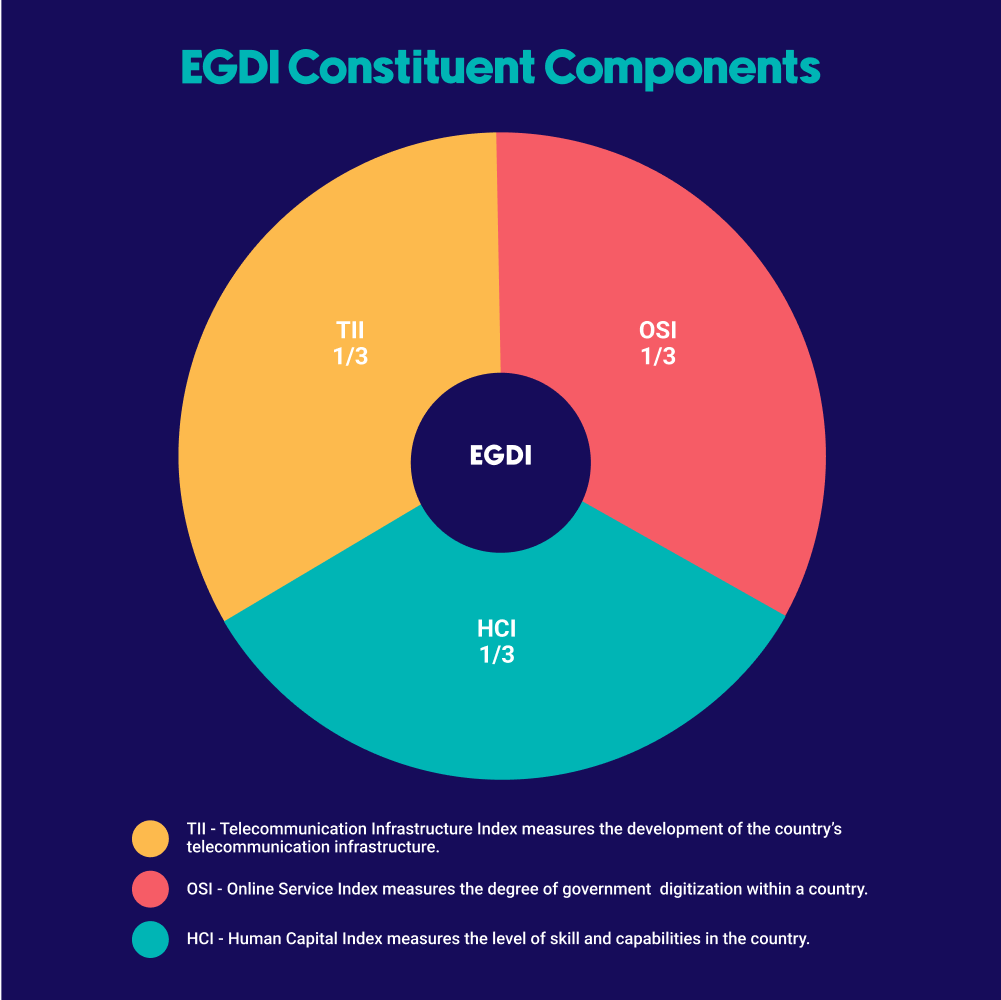
Despite improvement, Pakistan continues to underperform on the EGDI
The average global EGDI score rose by 2% between 2020 and 2022. Two-thirds of the countries covered in the index now fall into the High or Very High EGDI groups.1
During this same period, Pakistan’s EGDI score rose by only 1.3%. In relative terms, Pakistan’s EGDI score is 31% lower than the global average. This ranks Pakistan at 150 out of 193 countries in the index, making it a Middle-EGDI performer with a meagre rank improvement of 3 positions. Worryingly, the EGDI score gap between Pakistan and other countries is inflating.
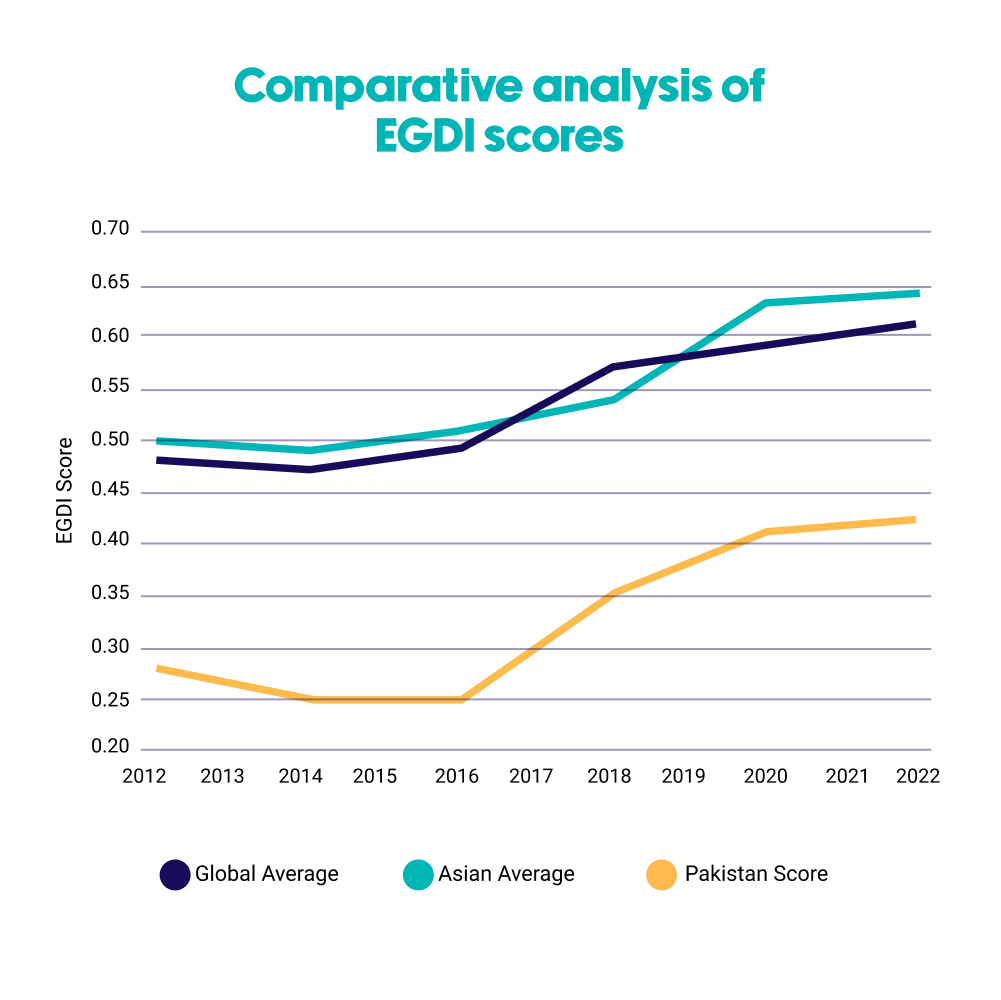
Looking at the region, Pakistan’s EGDI score is 35% lower than the Asian average, placing Pakistan as the fifth worst e-government regime in the region. An analysis of regional EGDI performance over the last two decades reflects the relative progress countries have made towards government digitisation. While Pakistan started off at a comparably strong position, the country’s overall EGDI rank has declined in this period. On the other hand, countries like Bhutan and Bangladesh have shown steep growth, leaving Pakistan behind.
Pakistan’s 13 rank fall in the last two decades – despite a 71% increase in absolute EGDI score – highlights the relatively slow pace of digital government transformation in the country.
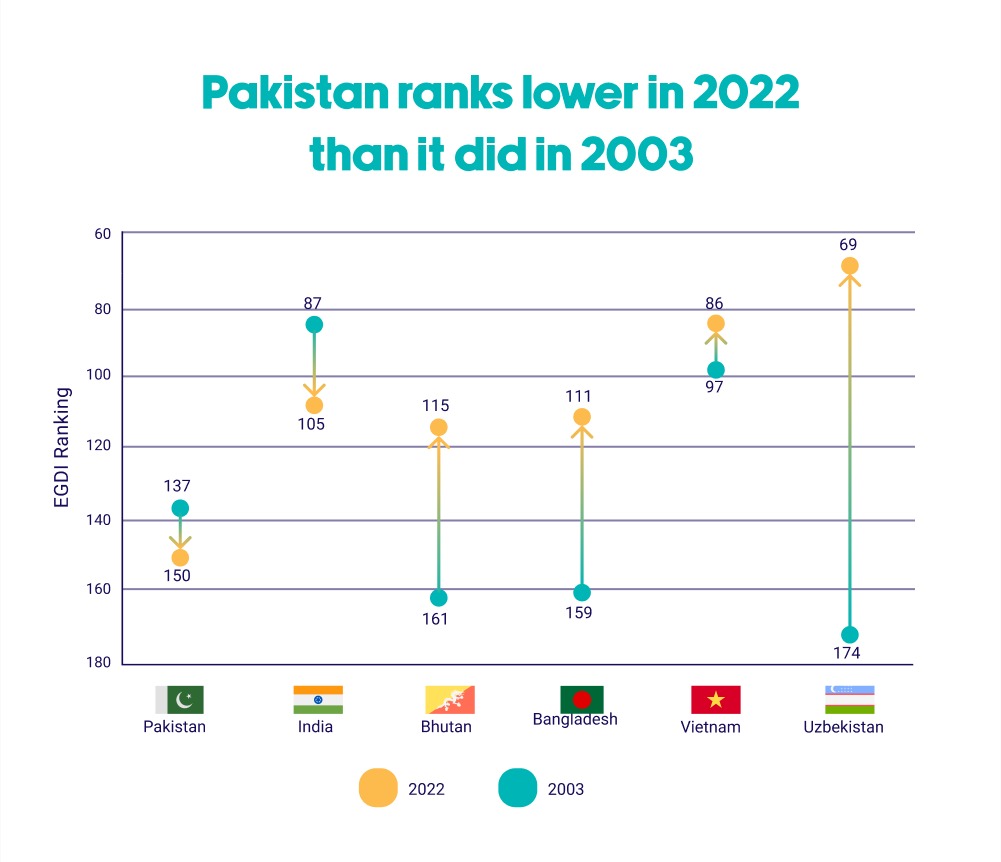
Understanding Pakistan’s wavering EGDI performance
A closer look at the last decade alone reveals an overall improvement in Pakistan’s EGDI rank and score. However, the country’s trajectory is characterised by a slow and fluctuating growth in ranking. The phases of Pakistan’s EGDI performance over the last decade are summarised below:
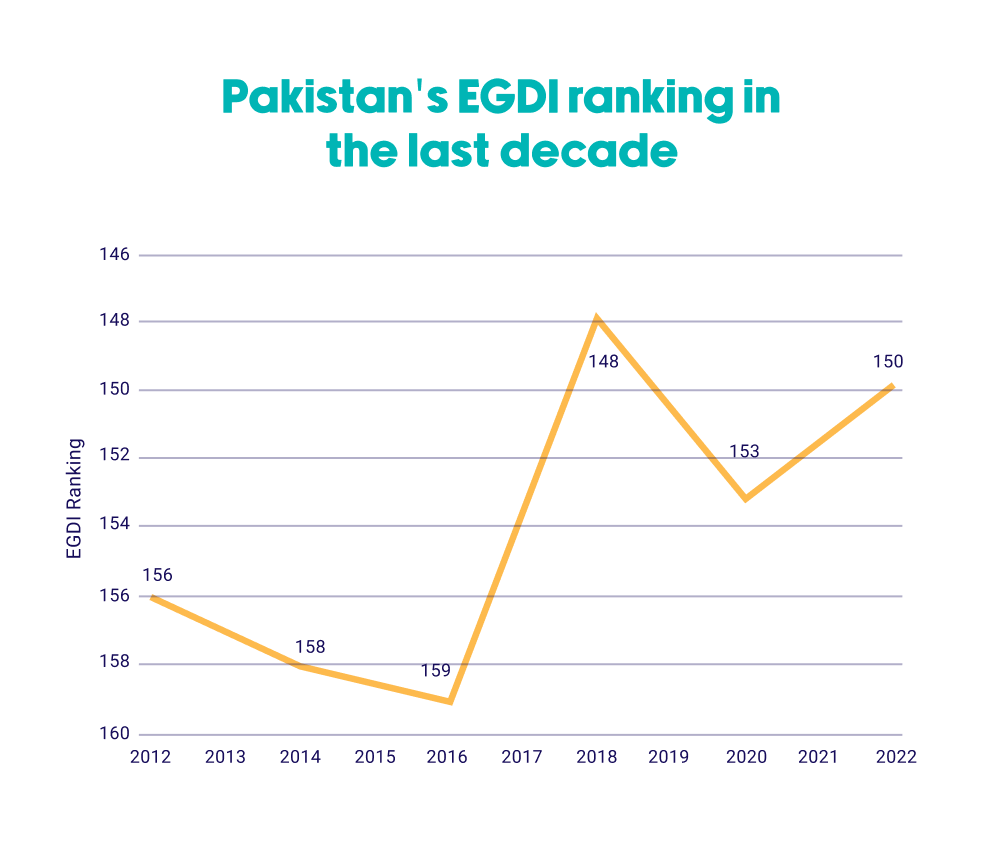
- 2012 – 2016: Decrease in rankings by 3 positions, demonstrating a consistently declining trend
- 2016 – 2018: Dramatic improvement of 11 positions in ranking, coinciding with the launch of the Digital Pakistan Policy, 2018
- 2018 – 2020: A 5 position drop in ranking, marking another dip in the country’s performance
- 2020 – 2022: A slight improvement of 3 positions, despite the covid-driven impetus to accelerate digitisation.
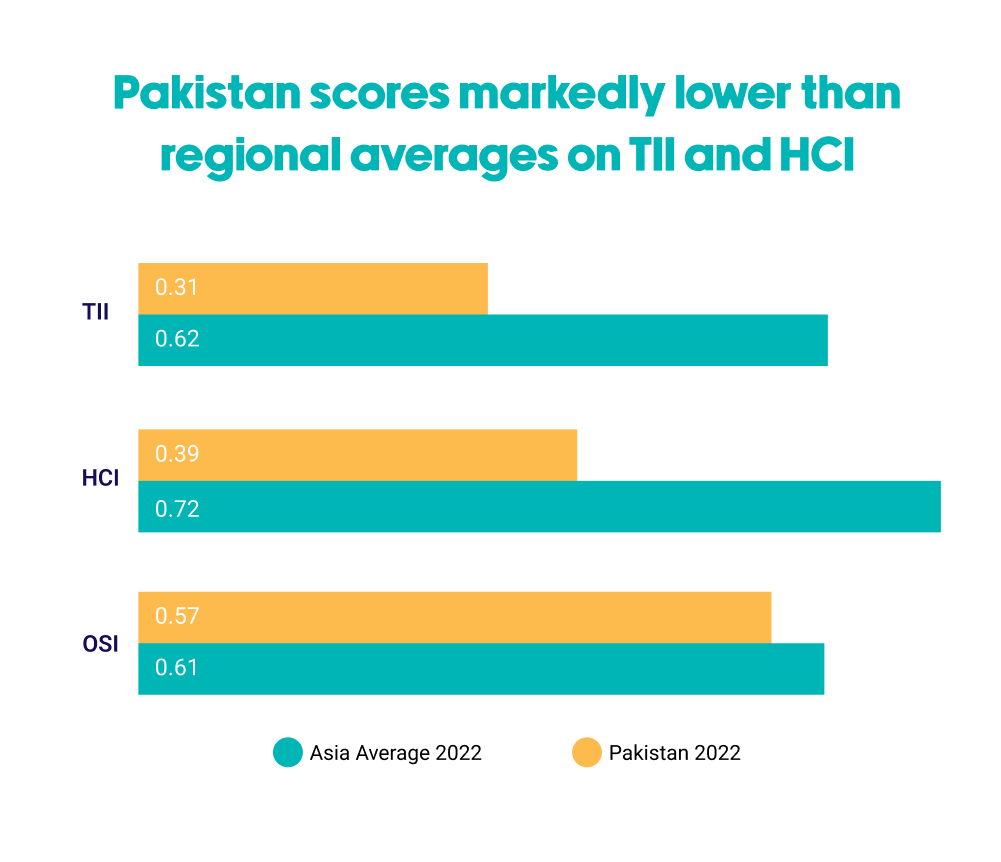
Out of the three components measured on the EGDI, Pakistan’s consistent low performance on TII (Telecommunication Infrastructure Index) and HCI (Human Capital Index) have resulted in a low overall EGDI score over the years. While TII and HCI show the quality of the enabling digital ecosystem, OSI (Online Service Index) measures the provision of public service delivery – the fundamental component of any digital government agenda.
Pakistan’s poor core internet connectivity is reflected in its low TII score – which was almost 50% below the regional average this year. While there are approximately 124 million mobile broadband subscribers in the country, according to the EGDI only 1.14% are active subscribers. This indicates limited access and shallow uptake of internet services.
Pakistan’s below average performance on the HCI suggests that citizens’ access to digital services is further compromised. The country’s 58% adult literacy rate indicates low levels of digital literacy, restricting citizens’ ability to meaningfully engage with digital technologies.
In contrast to the TII and HCI scores, Pakistan’s performance on the OSI has been significantly better, with scores higher than global and subregional averages providing a significant boost to Pakistan’s overall EGDI performance. Pakistan scores 2% and 6% higher than global and South – Asian average, respectively.
Unpacking Pakistan’s high OSI score reveals poor digital service delivery
Interestingly, Pakistan’s rise along the OSI is fairly recent. Until 2016, Pakistan’s OSI scores fell in the low-mid OSI range. However, in the 2018 edition of the EGDI, Pakistan’s absolute OSI score increased by 68%, promoting the country to the High OSI group. This sharp rise reflects a focus towards online government service delivery.
While there has been undeniable progress in digitisation of public services, the high OSI ranking is not accompanied by a corresponding sophistication in integrated digital service delivery. The disconnect between the ranking and user experience is better understood by unpacking Pakistan’s OSI scores.
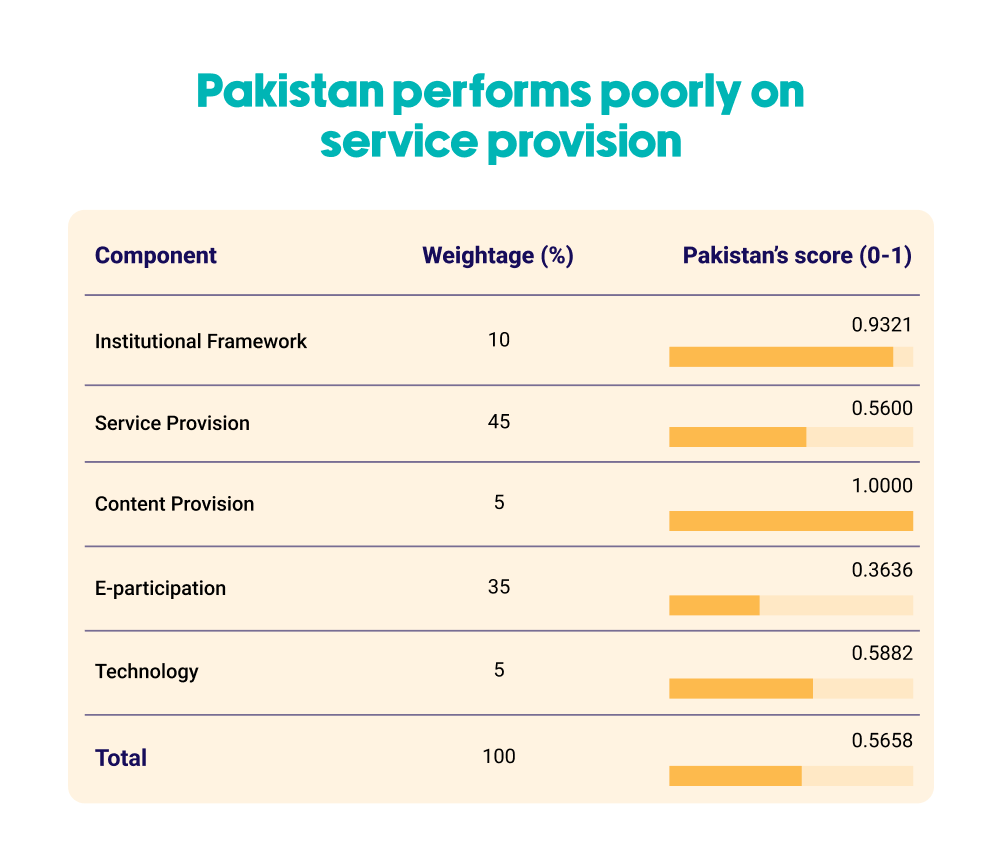
The composite OSI measures countries against five aspects of digital service delivery: (i) Institutional Framework, (ii) Service Provision, (iii) Content Provision, (iv) E-Participation, (v) Technology. Service provision and e-participation indicators carry 80% of the total weightage.
Unsurprisingly, Pakistan performed very poorly across service provision and e-participation. However, a perfect score in content provision, and a high score on institutional framework development, skews the results to create a high OSI score. As such, the OSI ranking does not paint an accurate picture of Pakistan’s e-government ecosystem, failing to adequately capture the sophistication and maturity of digital initiatives.
Pakistan’s EGDI performance shows persistent systemic gaps in the e-government ecosystem
Digital government maturity continues to be shallow, indicating gaps in a coherent and integrated digital government strategy. Some of the more pervasive issues include:
Prioritisation of content provision over service delivery: Online content provision is the lowest rung of e-government development, comprising a non-interactive web page which merely publishes relevant information. Conversely, online service provision is the digitised delivery of services, usually through an interactive, one-stop-shop portal.
Focusing on the former has restricted the growth of Pakistan’s digital government agenda, and limited the depth of digital service delivery in the country.
Global e-government leaders, as well as countries that have recently leapfrogged, show that growth in this space is predicated on the shift to a transformational model of e-government one that provides end-to-end digitisation across all stages of service delivery. Regional leaders in the Very-High category on average score 33% more on Service Provision than Pakistan.
Limited focus on citizen centricity: Pakistan’s current digital government landscape has relied on replication of existing service delivery processes reflecting internal government workflows. Inevitably, the focus of government digitisation has been procedural compliance rather than citizen need and ease. An outcome of this is the existing plethora of websites at the provincial and federal level for specific programmes and organisations. In contrast, almost three quarters of surveyed countries have single access points for all government services, such as “gov.uk” and “gov.rw” for the UK and Rwanda respectively, which are designed to optimise user journey for digital public services. Although there has been some provincial level progress with the introduction of the GoPunjab app and KP’s Super App, the scalability and efficiency of these apps remains to be tested.
Pakistan’s predominant focus on complaint and grievance redressal has led to a limited scope for citizen engagement through digital portals, as reflected in the country’s poor e-participation ranking (106). This leads to lower prioritisation of participatory approaches that can seek inputs for planning and implementation of key policies, programmes, and services through proactive digital engagement.
Fragmented and siloed governance: The increased legislative, policy and regulatory activity around the digital agenda in recent years is reflected in Pakistan’s high score (92%) on the institutional framework sub-indicator. However, implementation of these policies remains constrained due to institutional and governance considerations under a federal structure. Although federal and provincial governments continue to develop and grow their respective digital services portfolios, the absence of a coherent and organised national agenda and plan creates a noticeable difference in digital public service delivery across provinces.
Moreover, a lack of coordination and interoperability between and across different departments also leads to data silos, hindering a holistic, seamless experience for citizens. Real progress on the government digitisation front requires horizontal and vertical integration across federal and provincial departments.
Sustainable OSI growth: the Rwandan example
Rwanda, a low-income country with USD 720 GNI per capita, ranks 119 (out of 193) on the EGDI. The East-African country serves as a case study for countries with low TII and HCI, since it has progressed positively on OSI owing this progress specially to improved service delivery.
Rwanda’s OSI scores improved by 99% in the last decade. The improvement can be attributed to the country’s proactive implementation of core digital fundamentals vis-à-vis online services provision.
Rwanda’s major successes in this regard include:
- An increase in the number of online services being offered by public institutions. Currently, Rwanda offers 98 online services.
- Keeping user centricity as a driving force in defining the usability of these online services.
- The development of data-sharing mechanisms between departments to enhance inter-departmental collaboration. This has allowed the country to break silos resulting in cohesive policy decisions.

Arsala Khan
Arsala is an analyst at the Centre of Digital Transformation. He aims to bring interdisciplinary methods to research and policy making. Arsala's academic training is in Political Science and History from IBA, Karachi.
-
This author does not have any more posts.

Hiba Fatima
Hiba is a Senior Associate at the Centre for Digital Transformation. Hiba’s focus is on the intersection between digital and human development, public service delivery, and government. Her work aims to help different sectors benefit from digital transformation for improved economic and social opportunities. Hiba has an MSc. in International Politics from SOAS, and a BSc. in Economics and Political Science from LUMS.
-
Hiba Fatima#molongui-disabled-linkApril 28, 2023
-
Hiba Fatima#molongui-disabled-link






